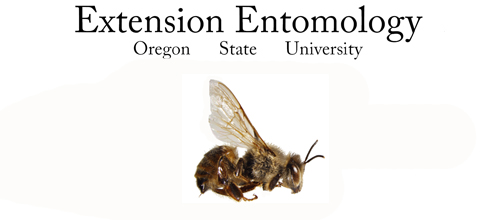Honey Bee Diagnostic Services
Varroa Mites
Causative Agent: Varroa destructor (Acari)
Range: Worldwide
Life cycle:
- Optimal developmental temperature for the mite is 32.9°C (bee developmental temperatures are: capped workers 34-36°C, capped drones 30-34°C; uncapped workers or droned 25°C)
- The rate at which eggs are laid is temperature dependent, ranging from 1.5 to 7 eggs per 31 to 39 hrs.
- The female must prepare a feeding site for her young (their mouthparts cannot penetrate the insect cuticle).
• A mated female mite enters the cell before it is capped and hides in the bottom of the cell.
• She promptly climbs through the jelly without eating it, to the top of the cell.
• She waits for the pre-pupa to molt before laying her eggs so they are not discarded to the bottom of the cell with the exuviae (moult).
• The female creates a feeding site and moves the leg III (metathoracic) to allow access to a feeding site.
Management:
- Monitoring:
- Sampling adults: capture 300-500 bees in jar directly or via shaking (warning: be careful not to collect the queen). Add 70% EtOH and let sit for several minutes. Gently swirl the jar and pour the contents into a light colored pan. Using tweezers and a small brush remove the bees one by one inspecting and removing any mites.
Infestation level is estimated using: (# of mites x 100) ÷ # of bees = % infested:
5%=slight, 5-10% seriously infested treat soon, 10-20% treat immediately, >20% great probability of colony failure in days to a weeks.
- Examination of sealed brood: using a 8 x 4 cm template and a sharp knife, remove approximately 300 sealed brood cells. Using tweezers carefully remove the pupae and wash them in 70% EtOH. Using a fine brush remove any attached mites and wipe the inside of the emptied cell to search for mites. Record the number of bees that have mites not the number of mites.
Infestation rates can be estimated by using (# capped cells with mites x 100) ÷ # of bees. Infestation levels are the same as above.
- Natural-mite-fall: collect the number of mites that die on a daily basis (best for use after making a chemical application). This procedure involves using a collecting tray covered with margarine with a 3 x 3 mm screen to keep the bees off the tray. The tray should be rigid and easy to grease. The mites and margarine are scraped off and hot water is added to melt the margarine, wax and propolis. The mixture is then gently mixed and pored through a fine strainer. The mites left in the strainer can be removed with a sharp tap onto a white cloth or paper. Mortality rate can be calculated using: # of mites ÷ # of days the trap was out.
- Numerous chemical options are available. Currently soft chemicals, such as Apiguard, Apilife VAR, or MiteAway II are being suggested until more is known about CCD.
- Cultural/ Biotechnological: Uncapping/destroying drone brood to remove developing mites. The developmental temperature range of drones best fits the mites, therefore removing drones may be an option. This can be done by manually uncapping and washing the cells, removing the frame from the colony and letting it die naturally or by heating.
Pesticide Information Center OnLine Output
Crop EQ BEE HIVE
States EQ OR
Year EQ 2007 |
AND |
Pest EQ VARROA MITE
States EQ OR
Year EQ 2007 |
NAME |
EPA # |
SLN # |
INGREDIENT |
CONCENTRATION |
REGISTRANT NAME |
APIGUARD |
79671-1 |
|
THYMOL |
25% |
VITA -EUROPE- LTD |
MITE-AWAY II |
75710-1 |
|
FORMIC ACID |
48.4% |
NOD APIARY PRODUCTS |
Other Useful Sites:
http://creatures.ifas.ufl.edu/misc/bees/varroa_mite.htm
http://www.ars.usda.gov/is/pr/2001/010228.htm
References:
Fernandez, N. & Y. Coineau Varroa; the serial killer . Atlantica, Biarritz . 2006.
Printable pdf version
|
